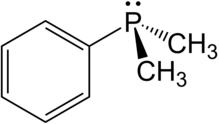Informatics Educational Institutions & Programs
Contents

| |||
| |||
| Names | |||
|---|---|---|---|
| Preferred IUPAC name
Dimethyl(phenyl)phosphane | |||
| Other names
Dimethylphenylphosphine
| |||
| Identifiers | |||
3D model (JSmol)
|
|||
| ChEBI | |||
| ChemSpider | |||
| ECHA InfoCard | 100.010.543 | ||
| EC Number |
| ||
PubChem CID
|
|||
| UNII | |||
CompTox Dashboard (EPA)
|
|||
| |||
| |||
| Properties | |||
| C8H11P | |||
| Molar mass | 138.14 g/mol | ||
| Appearance | transparent light pale yellow liquid | ||
| Density | 0.971 g/cm3 | ||
| Melting point | N/A | ||
| Boiling point | 74 to 75 °C (165 to 167 °F; 347 to 348 K) at 12 mmHg | ||
| Insoluble | |||
| Structure | |||
| Pyramidal | |||
| Hazards | |||
| GHS labelling: | |||
 
| |||
| Warning | |||
| H226, H315, H319, H335 | |||
| P210, P233, P240, P241, P242, P243, P261, P264, P271, P280, P302+P352, P303+P361+P353, P304+P340, P305+P351+P338, P312, P321, P332+P313, P337+P313, P362, P370+P378, P403+P233, P403+P235, P405, P501 | |||
| Flash point | 49 °C (120 °F; 322 K) | ||
| Safety data sheet (SDS) | [1] | ||
Except where otherwise noted, data are given for materials in their standard state (at 25 °C [77 °F], 100 kPa).
| |||
Dimethylphenylphosphine is an organophosphorus compound with a formula P(C6H5)(CH3)2. The phosphorus is connected to a phenyl group and two methyl groups, making it the simplest aromatic alkylphosphine. It is colorless air sensitive liquid. It is a member of series (CH3)3-n(C6H5)2P that also includes n = 0, n = 2, and n = 3 that are often employed as ligands in metal phosphine complexes.
Preparation
Dimethylphenylphosphine is prepared by the reaction of methylmagnesium halide with dichlorophenylphosphine.
- (C6H5)Cl2P + 2CH3MgBr → (C6H5)(CH3)2P + 2MgBrCl
The phosphine is purified by distillation under reduced pressure.[1] A solution of (C6H5)(CH3)2P in CDCl3 shows proton NMR signals at δ 7.0-7.5 and a doublet at δ 1.2. The phosphorus-31 NMR spectrum shows a singlet at -45.9 ppm in CDCl3.[2]
Structure and properties
Dimethylphenylphosphine is a pyramidal molecule where the phenyl group and two methyl groups are connected to the phosphorus. The bond length and angles are the following: P-CMe: 1.844, P-CPh: 1.845 Å, C-C: 1.401 Å, C-HMe: 1.090 Å, C-HPh: 1.067 Å, C-P-C: 96.9°, C-P-C (ring): 103.4°, P-C-H: 115.2°.[3]
When attached to chiral metal centers, the P-methyl groups are diastereotopic, appearing as separate doublets in the 1H NMR spectrum.
The νCO of IrCl(CO)(PPh3)2 and IrCl(CO)(PMe2Ph)2 are both at 1960 cm−1, whereas νCO for IrCl(CO)(PMe3)2 is at 1938 cm−1.[4][5]
In terms of basicity, dimethylphenylphosphine is intermediate between that of trialkyl- and triphenylphosphine:[6][7]
- [HPEt3]+ = 8.7
- [HPMe2Ph]+ = 6.8
- [HPPh3]+ = 2.7
The ligand cone angle (θ) is the apex angle of a cylindrical cone, which is centered 2.28 Å from the center of the P atom. However, the cone angle of an unsymmetrical ligand cannot be determined in the same. In order to determine an effective cone angle for an unsymmetrical ligand PX1X2X3, the following equation is used:
Where θi represent the half angle.
The resulting angles for PMe3, PMe2Ph, PPh3 are: PMe3 = 118°, PMe2Ph = 122°, PPh3 = 145°. Thus, PMe2Ph is intermediate in size relative to PMe3 and PPh3.[8]
References
- ^ C. Frajerman; B. Meunier (1983). Preparation of Dimethylphenylphosphine. Inorganic Syntheses. Vol. 22. pp. 133–135. doi:10.1002/9780470132531. ISBN 9780470132531.
- ^ Laszlo T. Mika; Laszlo Orha; Norbert Farkas; Istvan T. Horváth (2009). "Efficient Synthesis of Water-Soluble Alkyl-bis(m-sulfonated-phenyl)- and Dialkyl-(m-sulfonated-phenyl)-phosphines and Their Evaluation in Rhodium-Catalyzed Hydrogenation of Maleic Acid in Water". Organometallics. 28 (5): 1593. doi:10.1021/om800570r.
- ^ Novikov, V. P.; Kolomeets, V. I., Syshchikov, Yu. N.; Vilkov, L. V.; Yarkov, A. V.; Tsvetkov, E. N.; Raevskii, O.A. "Investigation of structure of dimethylphenylphosphine by means of gas-phase electron diffraction and vibrational spectroscopy" Zh. Strukt. Khim. (J. Struc. Chem.) 1984, volume 25, No. 5, 688. doi:10.1007/BF00747909
- ^ S. A. Cotton, Chemistry of Precious Metals., 1997, 152-157, ISBN 0-7514-0413-6, ISBN 978-0-7514-0413-5
- ^ A. R. Norris; J. A. V. Kessel, "Oxidative addition of 3,5-Dinitrobenzoyl Chloride to trans-Chlorocarbonylbis(dimethylphenylphosphine)iridium(I) Canadian Journal of Chemistry, 1973, volume 51, 4145-4151, doi:10.1139/CJC-51-24-4145.
- ^ Russell C. Bush; Robert J. Angelici (1988). "Phosphine Basicities As Determined by Enthalpies of Protonation". Inorg. Chem. 27 (4): 681–686. doi:10.1021/ic00277a022.
- ^ Tianshu Li; Alan J. Lough; Robert H. Morris (2007). "An Acidity scale of Tetrafluoroborate Salts of Phosphonium and Iron Hydride compounds in [D2]Dichloromethane". Chemistry: A European Journal. 13 (13): 3796–3803. doi:10.1002/chem.200601484. PMID 17245785..
- ^ C. A. Tolman, Chem. Rev., Steric effects of Phosphorus Ligands in Organometallic Chemistry and Homogeneous Catalysis., 1977, volume 77, pages 313-348. doi:10.1021/cr60307a002




















